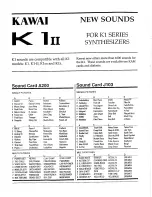
1. WELCOME TO CZ V!
1.1. Emulating Casio's Phase Distortion Synthesis
The CZ V is Arturia’s faithful re-creation, in virtual instrument form, of the Casio CZ series of
synthesizers which were introduced in the mid-1980s. Eight different models of the CZ series
were built, ranging from the budget-priced CZ 101 up to the full-scale CZ 1. In a sense, the CZ
synths were a bridge between the traditional subtractive synthesis method used by Moog,
Arp, Oberheim, and Sequential Circuits, and the FM synthesis method used by Yamaha in
their DX7 series. Famous artists who used CZ synths include Cirrus, Moby, Jimi Tenor, Vince
Clarke, Jimmy Edgar, The Orb, JeanMichel Jarre, and They Might Be Giants.
The unique sound character of CZ synthesizers stems from their use of a synthesis
technique called
phase distortion (PD). Instead of starting with a single, static waveform
from an oscillator with a fixed set of harmonic overtones (such as a square wave, sawtooth
wave etc.), which is then dynamically filtered to change the tone, PD synthesis starts with a
dynamic waveform that changes its overtones over time, yielding classic synth sounds at a
lower cost.
For example, a PD waveform may begin its attack as a sine wave, morph into a square
wave, and decay back into a sine wave, under the control of an envelope. Casio called
this a Digital Control Wave, or DCW. This allows the CZ to emulate the filter sweep effect
of a traditional analog synthesizer without the expense of multipole filters (VCFs). To
further emulate this effect, three of the stock waveforms are resonant versions of triangle,
trapezoidal, and sawtooth waves.
In PD synthesis, it is possible to create a compound waveform with two different halves:
for example, the first cycle can be a sawtooth wave, and the second cycle can be a pulse
wave. It’s like getting two oscillators for the price of one. In the original hardware, you had a
choice of eight different waveforms; the CZ V gives you those, plus the ability to draw your
own waveform. In the original keyboards, you couldn’t combine two resonant waveforms;
our modern software instrument doesn’t have that limitation.
There are two Lines available to generate sound in the CZ, and each Line has its own
waveforms, Pitch, DCW, and Amplitude envelopes, as well as Level and Pan controls.
When both Lines are enabled, one line can be detuned from the other across a six-octave
range. The two lines can be ring modulated to create entirely different sum and difference
frequencies, a classic synthesizer technique. A noise generator and noise modulation
complete the sonic possibilities.
One of the good things about the CZ line is that they were much easier to program than
a DX7 (for example) due to their simpler architecture. Each button allowed the musician to
access a restricted control set fitting in the small display screen. The only difficulty was
editing envelopes because no real-time graphic display of a current state was available (like
every synth at that time).
With the Arturia CZ V, you get the classic Casio sounds in a virtual instrument, with a
modern graphic user display that is intuitive to use and offers more creative control. We
have added several other features to bring CZ synthesis into the 21st century, without
changing its classic capabilities: internal digital signal processing (reverb, chorus,
compression, overdrive, etc.), a 16-by-16 modulation matrix (so you can map almost any
modulation source to any destination), a multisegment envelope option featuring up to 16
segments with adjustable slopes, the ability to stack up to 8 voices in unison, and more.
Most importantly, while the Casio CZ-101 and CZ-1000 had only eight DCOs (Digitally
Controlled Oscillators), limiting the polyphony to 8 voices, (only 4 voices if two Lines were
used simultaneously), the CZ V has up to 32-voice polyphony even when two Lines are in
use.
Arturia - User Manual CZ V - WELCOME TO CZ V!
4
Содержание CZ V
Страница 1: ...USER MANUAL ...
Страница 8: ...10 SOFTWARE LICENSE AGREEMENT 92 ...










































